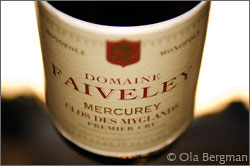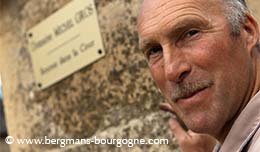
rwan Faiveley was thrown in at the deep end in December 2004 when he was put in charge of one of Burgundy's largest domaines – Domaine Faiveley in Nuits-Saint-Georges. He describes the first two-three years as very, very tough. Since then he has caused quite a stir by buying Domaine Annick Parent in Monthelie as well as five hectares of prime land in Puligny-Montrachet, including both Bâtard-Montrachet and Bienvenues-Bâtard- Montrachet.
– It was tough in the sense that I was 25 years old and many of the people here had been with the winery for 30-40 years, explains Erwan Faiveley. When you come in trying to change, as young people do, you realize how tough it is to change habits. But nevertheless, by the time you have convinced people it's amazing how faithful and great those people are.
He is the seventh generation running Domaine Faiveley. Pierre Faiveley founded the company in 1825. Since then it has grown to cover an impressing 120 hectares of vines in the Côte de Nuits, the Côte de Beaune and the Côte Chalonnaise. These vines produce more 80 percent of the wine that Faiveley sells. The rest is bought in as grapes, must or, as is the case with most their Bourgogne rouge and Bourgogne blanc, as finished wine.
– It was an obvious choice for me, says Erwan Faiveley about choosing a career in wine. But I never thought about doing it so quickly. I knew that I at some point would like to take over after my father, but I was planning on spending time on other businesses, maybe abroad, and come back later on.

Erwan Faiveley is now back in the house where he was born and raised, back in Nuits-Saint-Georges where he spent his first 15 years. Being the seventh Faiveley at the helm of the company obviously gives him a fair share of historical luggage to carry. He expected it to cause more stress than it actually did, but once he spent his days working most of it tended to be gone.
– Obviously there are more good things that come along with it, he says. Creating such a domaine today would be impossible. Not only because of the price of land, for it is very expensive, but also because you have to convince people to sell their vineyards to you.
– One of the last domaines that managed to do this was Dujac (in Morey-Saint-Denis). They bought an existing domaine. But doing something really from scratch, I don't see how you can do that today. So it's a very good thing to have something that already works.
Not counting the négociant wines Domaine Faiveley produces a total of 54 different wines, from the Gevrey-Chambertin premier cru of "La Combe aux Moines" at the northern end of the Côte de Nuits, via the company's flagship, the monopole of Corton, Clos des Cortons Faiveley in the Côte de Beaune, down to "Les Joncs" in Montagny at the southern end of the Côte Chalonnaise.
In April of 2008 it was announced that Domaine Faiveley had acquired the five hectares of Domaine Monnot in Puligny-Montrachet, adding Bâtard-Montrachet, Bienvenues-Bâtard-Montachet, Puligny premiers crus Les Folatières, Les Referts and La Garenne, and village Puligny-Montrachet to the portfolio.

– It was part of the plan, says Erwan Faiveley about the acquisition. I just didn't expect the opportunity to come so quickly. You need some luck, and I was pretty lucky.
When this opportunity came up he had been looking at Puligny-Montrachet and Chassagne-Montrachet for some time. He had been offered small plots of land on village level, but he was not convinced. He felt that if he was going to invest there it would have to include some of the best, some grand cru land.
– We are very lucky to have an amazing piece of Corton-Charlemagne, very well situated with old vines. I think that the people we have here at the winery, especially my cellar master, are very gifted. The Corton-Charlemagne is one of the greatest white wines in Burgundy, maybe in the world.
He feels that it would be a waste not to use this knowledge on other great whites in Burgundy. But five hectares in Puligny-Montrachet, with some grand cru thrown in, come with a hefty price tag. Erwan Faiveley will not tell you what he wrote on the check, but he will tell that it is difficult to get land investments in Burgundy to pay off.
– It is difficult, he smiles, if you are investing to make money. All the calculations I have done on this show that the return will be something like 20-25 years.
– My father has run the winery for 30 years and my general manager has run another winery for 20 years. Both have told me that if you just look at the price of land you will never buy any, because it will always be too expensive. But when you look back after five or ten years you will always feel that you should have bought more. Always.

2008 will be the first vintage for these new wines from Puligny-Montrachet.
– I tasted them this morning, says Erwan Faiveley. So far the malolactics are not done yet, so it's still too early to say how they will turn out. But we believe that 2008 will be a good vintage for the whites. The maturity was very good, contrary to 2007 that I think was more challenging.
2007 also saw Faiveley's acquisition of Domaine Annick Parent in Monthélie and the 12-year contract for the grapes from Domaine Matrot-Wittersheim in Meursault.
– When a domaine like Domaine Annick Parent comes up for sale you can't hesitate. There was a small piece of Pommard premier cru Les Rugiens. We had to go ahead. As for Domaine Matrot-Wittersheim we will tend the vines, do everything in the vineyards and then do the vinification. It's not a purchase or a lease, but it's not a négociant deal either.
Another major change at Domaine Faiveley is the change of barrel maker. The first steps had already been taken prior to Erwan Faiveley's arrival. The team in Nuits-Saint-Georges had begun experimenting with different barrels, from different manufacturers.

– My father has always had this idea of making great, long-lasting red burgundies. He has always vinified them in a very strict way, which is quite extracted. With the tannins and the power these wines were quite tough at the beginning. I like this style very much. Yet, some of our customers and friends told me that our wines had become too tough.
Since very little had changed in the winemaking process during the past decade or so – the team making the wines was still the same – they began to scrutinize everything involved.
– I came to the conclusion that the barrel maker did not make his barrels properly, explains Erwan Faiveley. I realized that he was selling us some very nice looking barrels, but that the wood was not dried enough. And when the wood is not dried enough you get some very green tannins. These green tannins would add to our very tannic wines and that would make some very tough wines. So we changed barrel maker in 2006 and now the style of the wines has changed. It's like day and night.
Recently the négociant part of Faiveley expanded with a range of Chablis wines. Quantities are limited, but the range covers the grand crus of Les Clos, Les Preuses and Vaudésir, the premier crus of Vaillons and Montmains and village Chablis.
– I'm crossing my fingers that at some point we could buy a small domaine there. Our new general manager Bernard Hervet used to be the general manager at Bouchard Père & Fils. He was also the one who recreated (the Chablis domaine) William Fèvre and he loves Chablis. He made a lot of friends when he was running William Fèvre. When he joined us some of his friends agreed to provide us with some great grape must.
But despite his recent purchases Erwan Faiveley is not in a hurry to buy more land in Burgundy. He is not interested in growing just to become bigger. He points out that during his 30 years at the company his father never got offered to buy any Bâtard-Montrachet. Grand cru land is simply very scarce, not to mention expensive.
– In any case it will have to be very good to convince me to write another check, he smiles.
© 2009 Ola Bergman














